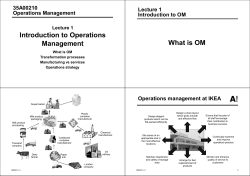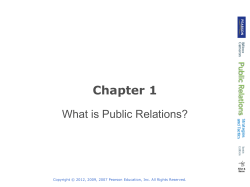
Introduction to Operations Management
1 Introduction to Operations Management PowerPoint presentation to accompany Heizer and Render Operations Management, 10e, Global Edition Principles of Operations Management, 8e, Global Edition PowerPoint slides by Jeff Heyl © 2011 Pearson Education 1-1 Why Study OM? 1. OM is one of three major functions of any organization, we want to study how people organize themselves for productive enterprise 2. We want (and need) to know how goods and services are produced 3. We want to understand what operations managers do 4. OM is such a costly part of an organization © 2011 Pearson Education 1-2 Ten Critical Decisions Ten Decision Areas 1. Design of goods and services 2. Managing quality 3. Process and capacity design 4. Location strategy 5. Layout strategy 6. Human resources and job design 7. Supply-chain management 8. Inventory, MRP, JIT 9. Scheduling 10. Maintenance © 2011 Pearson Education Chapter(s) 5 6, Supplement 6 7, Supplement 7 8 9 10 11, Supplement 11 12, 14, 16 13, 15 17 Table 1.2 1-3 Goods and Services Automobile Computer Installed carpeting Fast-food meal Restaurant meal/auto repair Hospital care Advertising agency/ investment management Consulting service/ teaching Counseling 100% 75 50 25 0 25 50 75 100% | | | | | | | | | Percent of Product that is a Good Percent of Product that is a Service © 2011 Pearson Education 1-4 Ethics and Social Responsibility Challenges facing operations managers: Developing and producing safe, quality products Maintaining a clean environment Providing a safe workplace Honoring stakeholder commitments © 2011 Pearson Education 1-5 Scope of Operations Management The scope of operations management ranges across the organization. The operations function includes many interrelated activities such as: Forecasting Capacity planning Facilities and layout Scheduling Managing inventories Assuring quality Motivating employees Deciding where to locate facilities And more . . . Student Slides 1-6 Role of the Operations Manager The Operations Function consists of all activities directly related to producing goods or providing services. A primary function of the operations manager is to guide the system by decision making. – System Design Decisions – System Operation Decisions Student Slides 1-7 Why Study OM? • Every aspect of business affects or is affected by operations • Many service jobs are closely related to operations – – – – Financial services Marketing services Accounting services Information services • There is a significant amount of interaction and collaboration amongst the functional areas • It provides an excellent vehicle for understanding the world in which we live Student Slides 1-8 OM and Supply Chain Career Opportunities • • • • • • • • • Operations manager Supply chain manager Production analyst Schedule coordinator Production manager Industrial engineer Purchasing manager Inventory manager Quality manager Student Slides 1-9 Historical Evolution of OM • • • • • Industrial Revolution Scientific Management Human Relations Movement Decision Models and Management Science Influence of Japanese Manufacturers Student Slides 1-10 Key Issues for Operations Managers Today • • • • • Economic conditions Innovating Quality problems Risk management Competing in a global economy Student Slides 1-11 The Need for Supply Chain Management • In the past, organizations did little to manage the supply chain beyond their own operations and immediate suppliers which led to numerous problems: – Oscillating inventory levels – Inventory stockouts – Late deliveries – Quality problems Student Slides 1-12 What is Operations Management? “ Operation Management is the set of activities that create goods and services through the transformation of inputs into outputs.” (Slack, 2001) 13 Typical Organization Chart Source: Reid and Sanders, 2005. 14 Activities of Operations manager Understand the operation’s strategic objectives Developing an operation’s strategy for the organization Designing the operation’s products, services and processes Planning and controlling the operation Improving the performance of the operation. 15 Some Activities of an Operations Manager Design elegant products which can be flat packed efficiently Storage Quality Design Store Layout Site Location 16 The input-transformation-output model Transformed resources Materials Information Customers Input Transforming resources Facilities Staff Source: Slack, 2001 Transformation process Output Goods and services Similarities-Service/Manufacturers All use technology Both have quality, productivity, & response issues All must forecast demand Each will have capacity, layout, and location issues All have customers and suppliers All have scheduling and staffing issues 18 Historical Development of OM Industrial revolution Scientific management Human relations movement Management science Computer age Just-in-Time Systems (JIT) Total quality management (TQM) Reengineering Flexibility Time-Based Competition Supply chain Management Global Competition Environmental Issues Electronic Commerce Late 1700s Early 1900’s 1930s to 1960s Mid-1900s 1970s 1980s 1980’s 1990s 1990s 1990s 1990’s 1990s 1990s Late 1990s 19 Today’s OM Environment Customers demand better quality, faster deliveries, and lower costs 20 Competitive Priorities- The Edge Four Important Operations Questions: Will you compete on – Cost? Quality? Time? Flexibility? All of the above? Some? Tradeoffs? Source: Reid and Sanders, 2005. 21 Lower prices (or higher profits) Faster customer response Cost Speed Quality Error-free products and services Dependability On-time deliveries Flexibility Wider variety More customisation More innovation Cope with volume fluctuations 22 Are There Priority Tradeoffs? Which priorities are “Order Qualifiers”? e.g. Must have excellent quality since everyone expects it Which priorities are “Order Winners”? e.g. Dell competes on all four priorities Southwest Airlines competes on cost McDonald’s competes on consistency FedEx competes on speed Custom tailors compete on flexibility Can you have both high quality and low cost? e.g. Yes, Coke and Pepsi are good examples Can you offer design flexibility and short delivery? e.g. Yes, modular housing manufacturers do it 23 Measuring Productivity Productivity is a measure of how efficiently inputs are converted to outputs Productivity = output/input Total Productivity Measure Total Productivity = $sales/inputs $ Partial Productivity Measure Partial Productivity = cars/employee Multifactor Productivity Measure Multi-factor Productivity = sales/total $costs Source: Reid and Sanders, 2005. 24 Highlights Business Strategy is a long range plan. Functions develop supporting plans Strategy must address mission, environment, and core competencies Business strategy provides a guide for designing operations strategy Operations strategy must consider which competitive priorities are essential to meet business objectives Competitive priorities are cost, quality, time, and flexibility Productivity measures how effectively a firm is using resources Productivity is computed as a ratio of outputs divided by inputs 25 References Reid R.D., and Sanders N. R., (2005) Operations Management, 2nd Edition, Wiley Publication. Slacks Nigel and Lewis Mike, (2002) Operations Management, Prentice Hall. 26
© Copyright 2025











